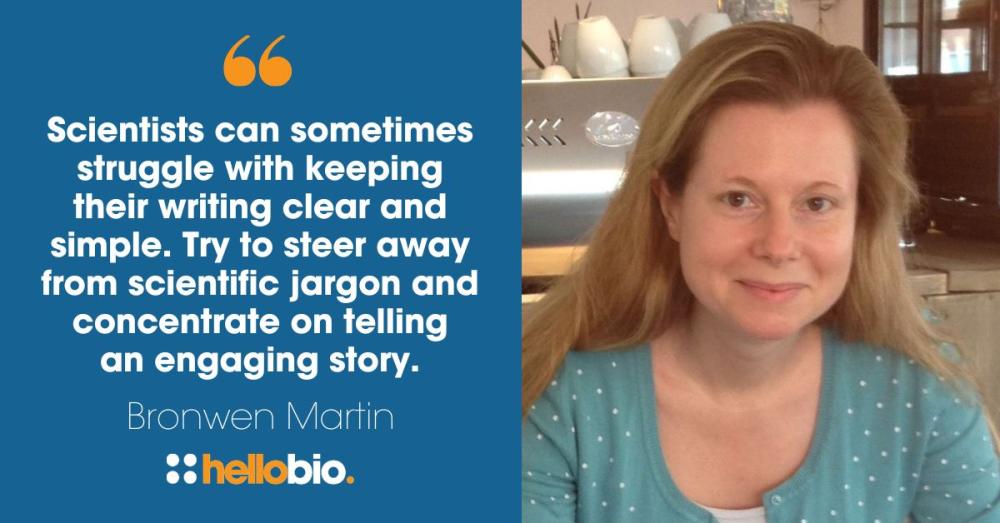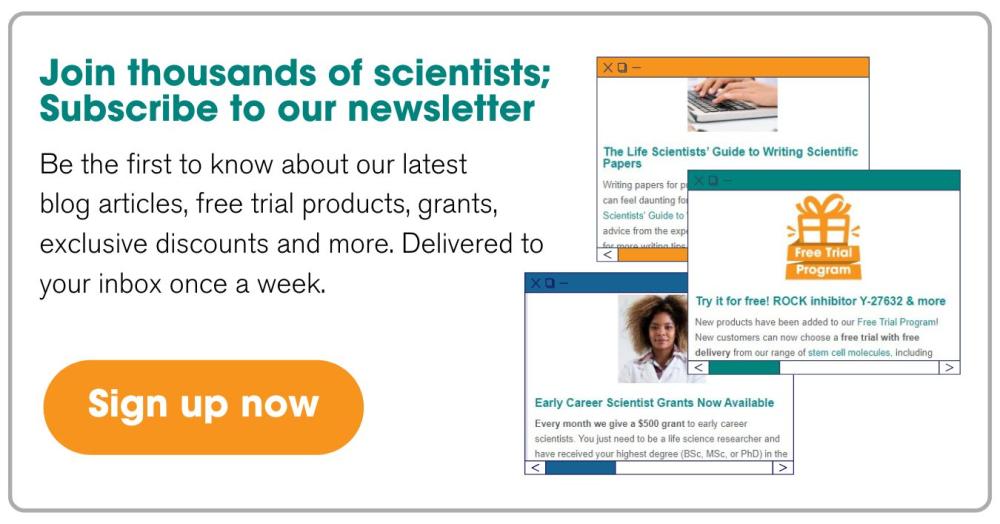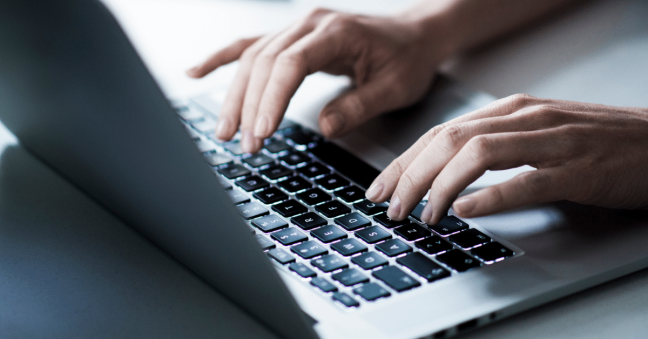Beyond the Manuscript: Maximizing Impact through Diverse Writing Outlets
For most life science researchers, science writing is an integral part of the job that takes time, skill and dedication. Learning to write well and having your work read by others is an important part of science research, and although scientific papers play a crucial role in disseminating data, they can be limited to a niche audience of STEM professionals and those already working in your field of research.
Research papers have a limited reach, therefore if you want to expand your readership it’s important to consider submitting your writing to more diverse publishing outlets. In this article, Dr Bronwen Martin looks in more detail at alternative places to publish your science writing, such as social media, online blogs, press, and specialist science magazines. As well as sharing general science writing tips, she also considers why diversity of publication is so important, and looks at ways to adapt your writing style to make it more accessible to a wider audience.
Why should scientists explore diverse writing outlets?
Only communicating your research through scientific papers has a number of drawbacks, and can considerably limit the number of people who will read about you and your work. When publishing scientific papers, research data can often be stuck behind a paywall, significantly reducing the number of readers that can access it. Research papers are often heavy with technical language and jargon which only a certain number of readers will have the knowledge and understanding to follow.
By publishing in more diverse outlets you can expand the reach and impact of your work to broader audiences. Having your work published in a wider variety of places could put your ideas in front of researchers from different fields, policy makers, companies, students, funding agencies, venture capitalists, healthcare professionals, patients, and the general public. Enhancing the visibility of your work gives you the opportunity to showcase your expertise and create connections and collaborations beyond your immediate academic circles.
Adapting your writing style
When writing for social media, blogs, magazines or the press, you’ll need to adapt your writing style away from the more formal scientific writing you may be used to. Here are some things to bear in mind when sitting down to write for an alternative outlet:
- Spark curiosity with a catchy title - You’ll want to grab people’s interest from the outset, so think hard about the message you’re putting across and the things you want to say. A blog article with a catchy or snappy title will draw readers in quickly and make your words stand out from the others.
- Keep it simple and tell a story - Something that scientists can sometimes struggle with is keeping their writing clear and simple. Science writing has a tendency to be overly complicated, but when writing for more diverse publications, try to steer away from scientific jargon and concentrate on telling an engaging story. Readers will be interested in who you are and why you are passionate about your topic. If there’s a personal story behind your research, tell it!
- Use short sentences - For alternative audiences to follow your writing, keep your sentences short and use headings to break text down into shorter paragraphs. This will make your work easier to read and digest. Don’t overload the reader with complex information, and highlight any particularly nice quotes that really get to the heart of your work.
- Include good quality visuals - Another way to catch the eye of a reader is to include great visuals - eg. a photo of yourself in the lab, your bench set-up, or a colourful confocal image. Traditional science papers will often include more technical or graphical images, but for diverse publications this is something to avoid. Aim for a high quality, exciting image that will spark curiosity and make readers want to find out more.
- Add a bio and contact information - Be sure to add a short paragraph about yourself, especially at the end of a blog article (see mine below!). Writing in more diverse outlets will put your name and work in front of lots of potential new contacts and collaborators, so be sure they can find out more about you and can reach out to you easily if they wish.
Choosing an alternative writing outlet
There are a wide variety of outlets to consider when looking for an alternative place to publish your writing. Here we look in more detail and some of the more popular options, and highlight some of the things you need to consider when posting, pitching or publishing:
Social media
Social media is a great place to start because it has an incredibly wide reach, and most of the popular platforms are completely free to use. It’s also one of the quickest and most accessible ways to get your messages out into the world, and is a great way to connect, not only with other researchers but with the much wider general public too.
- Choosing the right platform - With a variety of platforms to choose from, it’s important to identify exactly which audience you’re hoping to reach, and to select a matching platform to help you reach that goal. Say for example you’re interested in collaborating with a specific company, then LinkedIn would be a great place to start as it is geared more towards a professional, business-based audience. If you’re looking to engage with other researchers or policy makers, then X(Twitter) would be a more appropriate platform for your message. If your work features nice images that really help to tell your story, then consider posting on Instagram, which is image-focused and very visually engaging.
- Writing for social media - Whichever platform you choose, remember that brevity is key when writing social posts. Keep your posts short and impactful, avoid long text and don’t try to convey more than one idea per post. Use hashtags to increase the discoverability of your posts. For example, if you work in the field of ageing, make sure you add #ageing with every post. Also, be sure to tag any relevant companies or collaborators in order to enhance your reach and gain additional engagement on your posts.
Blogs
Online blog articles are another great way to share your ideas in an accessible way. Platforms such as WordPress, Squarespace and Wix are popular spaces for creating personal blogs through which you can publish as much and and often as you like. Alternatively, you can offer to write as a guest blogger for an existing blog hosted by an individual, company or institution that already has an established audience. Some of the benefits of blogging include:
- Connectivity - Blogs will help you to reach different audiences outside of your immediate contacts list or social media circle, and will help you make connections with new people.
- Flexibility - Publishing your own blog will mean you have unlimited flexibility on things like word count and format. You can choose to lay out your article however you wish, with no external editor to make cuts or changes. You can add images and even video content. Also, blog articles are very easy to share via email or on social media by copying and pasting the URL link.
- Showcasing - Writing a blog is a great way to showcase not only your research, findings and discoveries, but also your personality and opinions. Hosting your own blog page allows you the freedom to express yourself in a way that might be more limited in other publishing spaces.
When writing blogs, keep in mind that your style should be engaging and accessible. Keep your content clear and easy to understand, and if self-publishing try not to get carried away with that unlimited word count!
When writing as a guest blogger, take note of any guidance from the blog hosts regarding format and style, and have a good look through previously published articles on their platform for a better idea of the type of writing they prefer to publish. Consider writing for the Hello Bio blog! They are always looking for new voices to share ideas, advice and stories to inspire early career life scientists: https://hellobio.com/blog.html
Media & press
Getting your written work into a press article for a newspaper or other news media outlet is more of a challenge, as you’ll need to attract the attention of journalists or editors in order to be considered for inclusion. Here are some ways to put yourself in the frame for mainstream publication:
- Write a press release - If your latest experiment hopes to achieve something newsworthy, or you have some exciting findings you’d like to share with the wider world, then writing and submitting your own press release is your first step towards media publication. If you’ve never written a press release before, contact your university press office and ask for advice and assistance. They should be able to share templates and examples of standard press release formats, and they will likely be willing to help you with the writing and submission process.
- Register your area of expertise - Consider submitting your name and details to an expertise database. Most universities will hold databases of individuals and their areas of knowledge and expertise that they can use when receiving requests from journalists for a quote on a particular topic. For example, for an article on World Dementia Day, they might request contact with a scientist who is studying neurodegenerative diseases. If you’ve registered this as an area of expertise within the database, you might be called upon to share your knowledge and opinions in a mainstream newspaper or other media article.
- Use plain language - When writing press articles it’s vital that you communicate your findings in plain language. One of the most common mistakes researchers make when writing for the general public is to use too much technical jargon and scientific language which simply won’t translate to a wider audience. Also, be sure to highlight the impact of your research and its potential applications in the real world. For the general public to engage with and understand scientific news stories, the content must be relatable and easy to digest.
Magazines
Seeing your work published in a specialist science magazine is a dream for most scientists, and to achieve this goal you’ll need to pitch an idea for an original and engaging article. There are a huge variety of science magazines out there who cover a wide selection of topics and specialisms. Titles such as The Conversation, New Scientist, Scientific American, Wired and EOS Magazine are popular, and welcome pitches from scientists who can simplify their research and highlight its impact in a fresh and engaging way.
If a magazine is interested in your pitch, it’s likely they’ll ask you to work alongside one of their journalists to produce the article together. An in-house journalist will be able to advise you on that particular magazine’s preferred format and writing style.
- Reach out - Be proactive by making contact with magazine journalists and editors via X(Twitter), LinkedIn or direct via email.
- Look and learn - Take some time to look through previous magazine archives and study the writing styles used. Learn from other published writers by noting which articles were most popular and why. Studying the work of other writers will help you to hone your skills and understand how best to express complex topics in the most simple ways.
- Be prepared for rejection - You’ll face a great deal of competition when pitching articles for popular science magazines, so be prepared to have your ideas turned down and try not to take it personally! Rejection is a big part of life as a scientist, so always try to use it as a learning experience. Ask for feedback, find out what could be improved upon, and use what you learn to make improvements for your next pitch. Don’t be afraid of rejection - it’s absolutely normal and there’s always something you can learn from it.
Effective science writing: 6 Top Tips
In summary, here are six top tips to remember when putting your science writing out there to the wider world:
1) Seek diverse outlets
Writing scientific papers is vital for your career progression, but remember that there are plenty of other ways to share your research. You’ve worked so hard on your experiments and writing up your findings - it would be a shame to restrict all that great work to such a niche audience. Take the time to simplify your writing and share it in more diverse outlets for maximum reach and impact.
2) Be clear and simple
One of the most important things to remember is to keep your writing clear and simple. Avoid jargon, don’t over complicate your sentence structures, and steer clear of overly technical terms that only a select number of readers will understand.
3) Know your audience
Adapt your writing style to suit your target audience. If you’re trying to reach companies, write in a professional, commercial style, etc. Think hard about who you're aiming to connect with and the best way to reach them.
4) Engage your readers
Use a clear narrative to engage your readers and tell a story. It’s human nature to be interested in a story, so make it personal by illustrating your points with real life examples, eg. if you've done field work somewhere unusual, you've spent time working in a different country, or you've interacted directly with patients that suffer from the disease that you're researching, use real examples to add warmth, colour and heart to your writing.
5) Seek feedback
Ask your mentor or supervisor to review your writing and give honest feedback. It’s great to get some extra input, and a fresh pair of eyes will be able to notice things you might not. However, be aware that everyone has a different writing style, so there is no right or wrong when it comes to the voice and tone of your writing. Don’t try to imitate others, find your own voice.
6) Enhance with visuals
Where possible, using good quality, eye-catching visuals to enhance your writing. Of course the text is what’s most important, but the human eye is drawn to striking photographs and images, so use this to grab people’s attention. Spend a little time setting up a great photo in the lab, or capturing a stunning microscopic image to illustrate your writing in the best way possible.
Connecting with others
Diverse writing outlets not only increase the reach of your research, but they can also create new opportunities and connections. You'll be surprised by how many new opportunities can come your way from a simple blog article. You never know where your scientific writing might lead you, so see it as a form of networking, of creating opportunities, and just getting your research out there to the wider world.
Effective science writing is not just about disseminating information, it's also about making new connections that could determine the course of your career path. So don't be afraid to put yourself out there, to write about your research and to make the most of every opportunity!
Watch Bronwen's talk at the Hello Bio LabLife Conference 2024
This article is based on Bronwen's talk entitled 'Beyond the Manuscript: Maximizing Impact through Diverse Writing Outlets' at the Hello Bio LabLife Conference on 18th January 2024. You can watch the full video plus audience Q&A session with Bronwen on the Hello Bio YouTube channel:
About the author
Dr. Bronwen Martin serves as the Scientific Editor and Research Communication & Outreach Coordinator in the Faculty of Pharmaceutical, Biomedical, and Veterinary Sciences at the University of Antwerp, Belgium. She earned her Ph.D. in Reproductive Endocrinology from the University of Edinburgh, UK, and pursued Postdoctoral training in Neuro-endocrinology at the National Institutes of Health and Johns Hopkins University, USA. Following her training, she was the Principal Investigator and Head of the Metabolism Lab at the National Institute on Aging, USA, focusing on investigating metabolic function during ageing. Bronwen has authored over 120 papers, serves on various journal editorial boards, and manages the social media channels for her faculty.
Read more articles by Bronwen Martin on the Hello Bio blog:
Connect with Bronwen:
- X(Twitter): @BronwenMMartin
- LinkedIn: Bronwen Martin
More useful articles on the Hello Bio blog
For more advice on science writing and getting your written work published, check out some of these other great resources on the Hello Bio blog:
- The Life Scientists' Guide to Getting Published
- The Life Scientists' Guide to Writing Scientific Papers
- 6 Top Science Writing Tips from the Experts
- The Art of Writing Scientific Papers - Resources for Researchers
- Five Essential Tips for Writing Scientific Papers - guest blog by Jasmine Pickford
- Scientific Papers: Tips for More Productive Writing - guest blog by Maria Montefinese
________________________________
If you enjoyed this article, why not check out the other resources available on our blog. We are passionate about supporting life scientists including early career life scientists and PhD students - with really low-priced reagents, antibodies and biochemicals, early career scientist grants, and resources to help with both personal and professional development. We know how tough it is - so we hope you find these helpful!
More General Support for Life Scientists
For advice on wellbeing, dissertations, presenting at conferences, wellbeing, PhD support, networking and lots more, we have a huge range of articles to help - just click below:
Save up to 50% on our high purity reagents...
When you get to the stage of planning your experiments, don't forget that we offer a range of low-cost, high-purity agonists, antagonists, inhibitors, activators, antibodies and fluorescent tools (yes - they really are around half the price of other suppliers!) You can use our Quick Multi-Search Tool to search for lots of products in one go, and the range includes:
- Enzyme inhibitors and activators
- Chemogenetic ligands
- Ion channel modulators
- GPCR & ionotropic receptor ligands
- Cell biology reagents & biochemicals
Technical resources
Try our Molarity Calculator: a quick and easy way to calculate the mass, volume or concentration required for making a solution.
Try our Dilution Calculator: an easy way to work out how to dilute stock solutions of known concentrations
We also offer a comprehensive range of technical resources including antibody protocols and methods, product guides and mini-reviews:
And finally, don't forget to check back in with our blog regularly for our latest articles. If there’s something you’d love to contribute to the community, whether that’s an interview or article, drop us a line at hello@hellobio.com
---



























